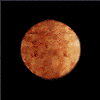|
~
Mercury |
||
Mercury is a small, rocky planet that is closest to the sun. It is covered with billions of craters where meteorites have struck its surface. Its varied terrain also includes gently rolling plains; smooth, flat plains; long, steep cliffs called scarps; and hills. Mercury's surface is covered with regolith, a layer of scattered rubble created by the same impacts that caused its craters. There are large sheets of ice on the planet's polar regions. Mercury has a very thin atmosphere that is made of hydrogen, helium, potassium, and sulfur. It is the only planet besides Venus without any moons. At an average distance of 36 million miles (58 millio km), Mercury is the closest planet to the Sun. Because of this it receives about seven times as much heat and light as the Earth does. In fact, it is hard to see the planet from Earth without a telescope because it is so close to the Sun. Mercury is the smallest inner planet; except for Pluto, it is the smallest planet. It is also a very dense planet. It would take 16 times the mass of Mercury to equal the mass of Earth. The planet's diameter is about 3,031 miles (4,878 km) - that's about two-fifths that of the Earth. Mercury's force of gravity is about one-third as strong as Earth's. Mercury travels around the Sun faster than any other planet - that's why the ancient Romans named it in honor of the swift messenger of their gods. However, the planet spins so slowly on its axis that one day on Mercury would last 59 Earth days. That means it rotates completely on its axis every 59 Earth days. It makes one revolution around the Sun every 88 Earth days. However, the time between sunrises on Mercury is 176 Earth days. The side of Mercury that faces the Sun gets hot enough to melt lead. The temperature on that side of the planet is about 801 degrees F (427 C). The side of Mercury that faces away from the Sun gets hundreds of degrees colder than any place on Earth. The temperature on that side of the planet is about -279 degrees F (-173 C).
|
||

